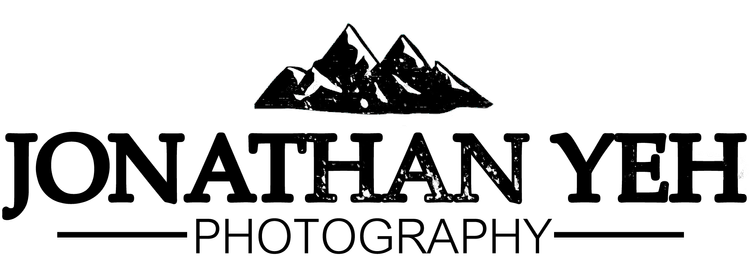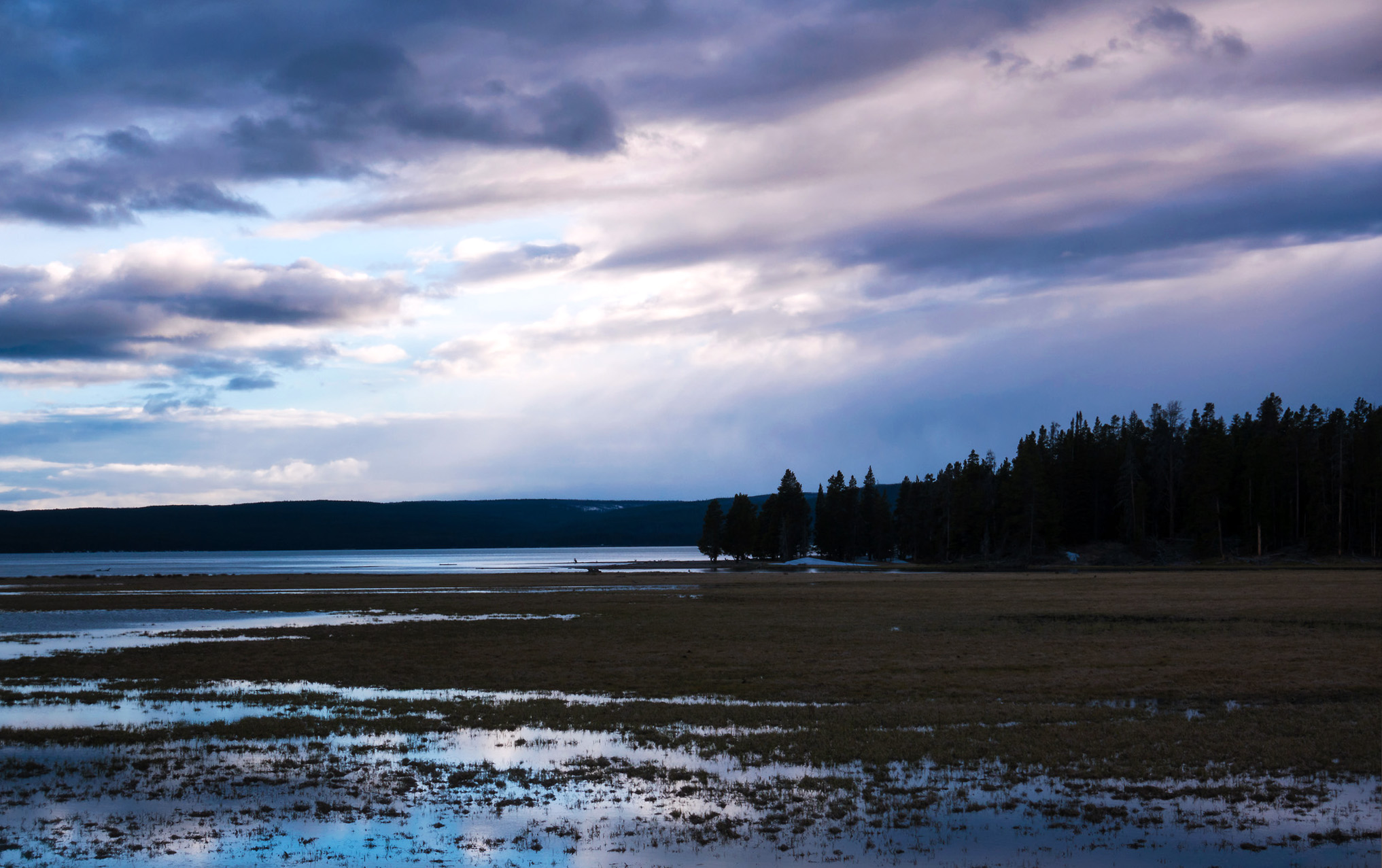Another early morning on the lake. Jane and I head west this time from the Lake Hotel, following the road under Elephant Back Mountain and past the Bridge Bay campground. A pearly pink sunrise is coming over the Absarokas, and from the west shore we can see steam vents rising into the morning air across the lake. In the dim light, we pass the wreckage of a little Volkswagen and a bloody doe carcass; it's hard to say which worse for the wear. At the tip of West Thumb, the road bifurcates, one way going south to Yellowstone's South Entrance and to the Tetons. We turn the other way, heading over Craig Pass and the Continental Divide to the western half of the Park, and to the world's largest expanse of active geysers and geothermal pools.
We arrive at the Upper Geyser Basin and park beside Old Faithful's classic wooden lodge shortly after 7 AM. The Basin, with its layers of parking mega-lots and fuel pumps, its ring of dining halls and lodges, and its shiny glass visitor center, looks more like a theme park or an airport terminal than a site of raw, wondrous vulcanism. It's still early, and the place is deserted except for a few morning joggers on the boardwalk. No other tripods besides mine. To Jane's and my disappointment respectively, the visitor center bathrooms and ice cream parlour in the lodge are not yet open. The place will gradually liven up as the morning goes on. For now, we set up shop right in front of Old Faithful itself, munching on our Southwest trail mix while my camera clicks off a time lapse.
This is my second time here. The first was in 1998, during my summer vacation after 3rd grade. We stayed in the Old Faithful Inn itself, in a tiny family room with a communal bathroom out in the hallway, and sallied forth with day trips around the park. I remember precious little of that trip: flipping through a cross-country trail guide and balking at the distances (I still do). Fleeting images of pine trees, so many pine trees! A big expanse of water that must have been the Lake. Douglas Wood's recording, Deep Woods, Deep Waters - purchased in a gift shop and first listened to on a rental car stereo - which has stayed with me all these years. The trip was cut short when Evelyn, just over a year old at the time, began running a fever. My parents blamed it on the communal bathroom. Still, it was nice to be able to lean out the window and see the world's most famous geyser do what it does. That was what I thought of, sitting there on a bench in front of Old Faithful, nineteen years later with my wife.
It's just me, Jane, and one other tourist there when Old Faithful erupts for the first time of the morning. We saunter off to the inn and step into a log-piled, high-arching atrium, with a roaring fireplace. "How... rustic," Jane murmurs. We both cringe; the word is moderately nauseating after a year of wedding planning. We browse the gift shop and pick out our first fridge magnet of the trip, a nail cutter for the pesky hangnail I've developed on my left pinky toe, and a book on roadside geology in the park. And a scoop of cookies and cream for me. And a sccop of caramel for Jane. We sit outside on the bench and watch another eruption go by while munching thoughtfully on our soon-to-be-daily ice cream ("The honeymoon is a dangerous time," Jane later says prosaically).
After ice cream, we take a stroll to the west along Firehole River, which flows through the geothermal basins of the western park to eventually join the Madison and Missouri Rivers. Looping back through the Upper Geyser Basin along the boardwalks, we pause to peer at the hot pools, steaming and brightly colored with mats of thermophilic bacteria and archaea. The air is rancid with sulphur. By the time we return to Old Faithful's hillside in the mid-morning, a sizeable crowd has surrounded the geyser, and more tourists still, following the countdown timer posted on the visitor center wall, are streaming forward with their children, strollers, and cameras in hand. Suddenly, a boom sounds over the basin, and there is a collective gasp from the crowd as a jet of water erupts from Beehive Geyser, Old Faithful's neighbor just down the hill and across the river. We stay to watch the two waterspouts put on a rare double performance.
Back in the car, we leave the carnival of the Old Faithful megaplex, driving a few miles down the valley to the Midway Geyser Basin. The parking lot there is crowded as well, and the wind is howling as we cross the bridge over the Firehole River and walk around the enormous crater of Excelsior Geyser, its runoff hissing and steaming as it contacts the river. Curtains of steam from Grand Prismatic Spring, the largest thermal lake in the United States, billow past us on the boardwalk like passing railway cars, and in between clouds we catch glimpses of brilliant cerulean water at the center of the pool, encircled by rims of flaming orange bacterial mats and travertine mineral deposits. Park Loop Road continues parallel to Firehole River until we reach the Lower Geyser Basin, with its bubbling mud pots and exuberant little geysers constantly spouting off beyond the boardwalk.
Next, the road splits at Madison Junction, where the Firehole and Gibbon Rivers join to form the Madison River, which heads westward before curving north toward the plains of western Montana. From there, it skirts around the Yellowstone Plateau to finally and circuitously join with the Atlantic-bound great rivers. We turn east to follow the course of the Gibbon upriver for a few miles, climbing Tuff Cliff and leaving the volcanic basin behind. At the top of the mountain pass, we reach our turnaround point for the day at Gibbon Falls.
Here, the river rushes over a scarp of granite just below the roadside, plunging from the upland forest of the northern park into the caldera below, striking a band of rock and forming a lovely fantail as it goes. From the overlook, there is a terrific view of the stream winding its way down the canyon past a hillside of blown-down pines. It would be a marvelously idyllic view but for the furious wind, which hurtles down mountains and whips up a flurry of red dirt from the talus slope behind us. We pack away our gear as the ground squirrels and nutcrackers go teetering past, shielding our eyes and our cameras from the sand blast.
Jane takes a nap as we retrace our long route south and then east (Park Loop Road being still under repair at the Yellowstone Canyon). The hour-and-a-half drive back to the shore of Yellowstone Lake is uneventful, except for a brief pullover to admire a herd of bison grazing on the creekside flats beneath Mary Mountain, and another stop beside Isa Lake near the top of Craig Pass, where we take a selfie astride the Continental Divide. Paradoxically, as with most of the nearby watersheds along the Divide, the lake drains into the Atlantic Ocean via its western waters (by flowing north and then east via the Madison River) and the Pacific Ocean via its eastern waters (by flowing south to Shoshone Lake and then to the Snake and Colorado Rivers). Interestingly, the road intersects the Divide twice, as the watershed doubles back on itself on the other end of the pass.
When we return to the lakeshore, it all but seems that the wind has pursued us through the geyser basins and over the mountains. It rushes down toward the center of the caldera, beating up whitecaps on Yellowstone Lake, and blowing a rust-colored cloud through the expanse of pine trees and toward the Absarokas. We head over to the general store to re-stock our food supply, and very nearly have to fight to prevent our car doors from being torn off by the gale. A late lunch secured, we beat a hasty retreat to our cabin. Jane has a tuna salad, while I wash down a turkey and cranberry sandwich with a bottle of chocolate milk. In celebration of the fact that we have nothing better to do, we take another luxurious afternoon nap.
In the early evening, we leave the cabin again, Jane accompanying me for yet another golden hour run. This time, we retrace our way north through Hayden Valley to the Canyon of the Yellowstone. It is just past 7 PM when we reach Artist Point, and the sunset throws a sidelight on the canyon walls, accentuating their hallmark yellow oxides. It takes me 8 bracketed exposures to fully capture the scene upriver: cliffs and spires basking in the golden light, while the falls thunder in the distance beyond a ribbon of winding white river. On our return through the valley, we pause at Trout Creek to photograph the lovely meander of the river, and finally pull over at the valley's southern-most overlook, where I set up a timelapse of the sun sinking into the grassland flats beside the Yellowstone River. One of the lovely things about landscape photography in Yellowstone, as we discover, is the people you meet by standing near a tripod off the side of the road during golden hour. On this evening, we are joined by a tall Ford pickup truck, whose driver is an older man who came from Texas with his grandson. "To see the wolves," he says. We trade wildlife stories ("Plenty o' coyote," he says with spot-on drawl and a silent 'e', "But none o' those gray wolves we seen settin' 'round here yet.") We tell him about the wolf we saw lazing around the hillside a mile down the valley, and he promises to return in the morning to resume his search. We stand for awhile on that hilltop over the valley, me with my camera, he and Jane with binoculars glued to their faces - each of us content with the land and the silence and the setting sun.















































